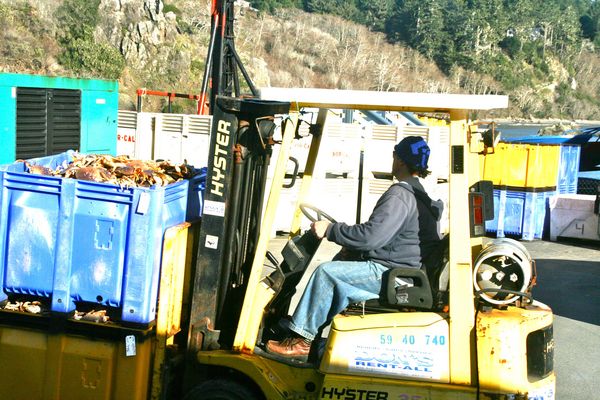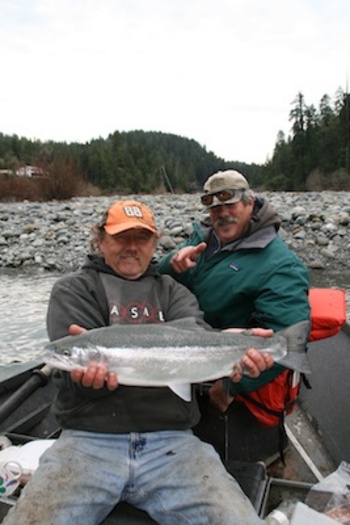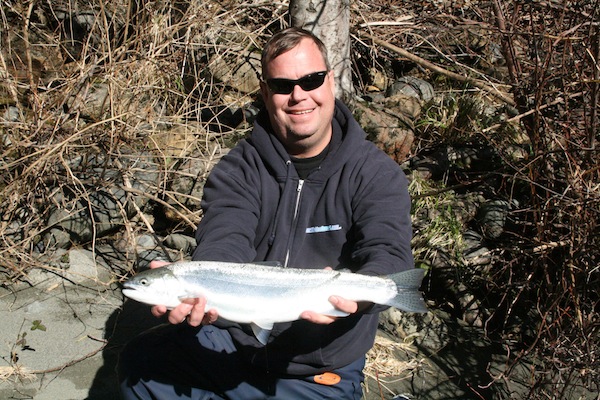Long Range Fish Report
From Sportfishing
From Sportfishing
Fish Report for 1-30-2011

Russ Izor would have been ahead of his time even now
1-30-2011
Rich Holland
Russ Izor paved the way to the future
Russ Izor. A name that may not be familiar to many fishermen these days, but one that still ties the past to the future in the California sportfishing scene. A short top shot? Some would have you think it's a recent development, but Izor was throwing baits into the thick of the kelp with a few feet of mono tied to Spectra 20 years ago.
As a matter of fact, it was Russ who, after many experiments, settled on Spectra as the fiber of choice for braided line. While he was building the state of the art 1980s 3/4-day boat, complete with hand wells for anchovies halfway up the wheelhouse on either side, Izor had the foresight to add staterooms, a design factor that has made the First String one of the top offshore boats of the last decade.
Izor came up while Chad Woods and I had dinner recently with Mark Pisano and Paul Strasser, who both started their careers as protégés of Izor and, besides Russ, were the first skippers of the String (now owned by Bradley Phillips).
Strasser and Pisano are now themselves at the forefront of the California fishing business, with a finger in practically all the pies, from owning landings and purse seiners to their own custom-built long range vessel, the Independence.
The subject of fish counts and Woods breakthrough innovation on this site (SportfishingReport.com), the first online boat-by-boat counts. It was pointed out how Izor could throw everyone for a loop when they only checked out the overall dock totals in the local newspaper. Many people believed you don't catch sand bass at Catalina, but Izor would regular take his customers to good catches of sandies and halibut at the island.
The big regret is that Izor wasn't around to rattle the chains of the MLPA autocrats. Just to see him at one of the Science Advisory Team meetings where so-called fisheries experts decided catch and release offered only a low level of protection to the ecosystem.
Izor's mantra was "We don't know where our fish come from" and he conducted what was up until that time the largest privately funded tagging program to try and determine the origin of SoCal's sand bass.
"We would tag those sand bass and catch them over and over again the same night," said Strasser. "If there's one thing I learned, it's that if you get on a spot of spawning sand bass, they'll stay there until you catch them all or the water temperature drops and they disappear."
If there's one thing this writer has learned over the last few years, it's that recreational and commercial fishermen can co-exist in well-managed, properly apportioned fisheries. The irony of many of the public debate is the rapid recovery of many of the groundfish species has been veiled in the rhetoric of destruction the anti-fishing side continues to spew. Even as we speak they have moved to block the easing of restrictions on seasons and size limits for lingcod despite data that clearly points to a healthy biomass.
Annual fluctuations in populations are something we have to deal with - and all to often lately - but the huge resurgence in the commercial Dungeness crab fishery this season after last season's dismal catch shows that a balance perspective must be maintained.
We still have a long way to go to answer all the questions Russ Izor posed, but the quicker those questions are answered, the better our chances of maintaining our right to fish.
PHOTO
TUBS OF TRINIDAD CRAB wheel down the pier after being offloaded from a boat that spends the rest of the year running recreational rockfish trips.
Russ Izor. A name that may not be familiar to many fishermen these days, but one that still ties the past to the future in the California sportfishing scene. A short top shot? Some would have you think it's a recent development, but Izor was throwing baits into the thick of the kelp with a few feet of mono tied to Spectra 20 years ago.
As a matter of fact, it was Russ who, after many experiments, settled on Spectra as the fiber of choice for braided line. While he was building the state of the art 1980s 3/4-day boat, complete with hand wells for anchovies halfway up the wheelhouse on either side, Izor had the foresight to add staterooms, a design factor that has made the First String one of the top offshore boats of the last decade.
Izor came up while Chad Woods and I had dinner recently with Mark Pisano and Paul Strasser, who both started their careers as protégés of Izor and, besides Russ, were the first skippers of the String (now owned by Bradley Phillips).
Strasser and Pisano are now themselves at the forefront of the California fishing business, with a finger in practically all the pies, from owning landings and purse seiners to their own custom-built long range vessel, the Independence.
The subject of fish counts and Woods breakthrough innovation on this site (SportfishingReport.com), the first online boat-by-boat counts. It was pointed out how Izor could throw everyone for a loop when they only checked out the overall dock totals in the local newspaper. Many people believed you don't catch sand bass at Catalina, but Izor would regular take his customers to good catches of sandies and halibut at the island.
The big regret is that Izor wasn't around to rattle the chains of the MLPA autocrats. Just to see him at one of the Science Advisory Team meetings where so-called fisheries experts decided catch and release offered only a low level of protection to the ecosystem.
Izor's mantra was "We don't know where our fish come from" and he conducted what was up until that time the largest privately funded tagging program to try and determine the origin of SoCal's sand bass.
"We would tag those sand bass and catch them over and over again the same night," said Strasser. "If there's one thing I learned, it's that if you get on a spot of spawning sand bass, they'll stay there until you catch them all or the water temperature drops and they disappear."
If there's one thing this writer has learned over the last few years, it's that recreational and commercial fishermen can co-exist in well-managed, properly apportioned fisheries. The irony of many of the public debate is the rapid recovery of many of the groundfish species has been veiled in the rhetoric of destruction the anti-fishing side continues to spew. Even as we speak they have moved to block the easing of restrictions on seasons and size limits for lingcod despite data that clearly points to a healthy biomass.
Annual fluctuations in populations are something we have to deal with - and all to often lately - but the huge resurgence in the commercial Dungeness crab fishery this season after last season's dismal catch shows that a balance perspective must be maintained.
We still have a long way to go to answer all the questions Russ Izor posed, but the quicker those questions are answered, the better our chances of maintaining our right to fish.
PHOTO
TUBS OF TRINIDAD CRAB wheel down the pier after being offloaded from a boat that spends the rest of the year running recreational rockfish trips.
Rich Holland's Roundup
< Previous Report Next Report >

LongRangeSportfishing.net © 2025. All Rights Reserved.
Website Hosting and Design provided by TECK.net
Website Hosting and Design provided by TECK.net

